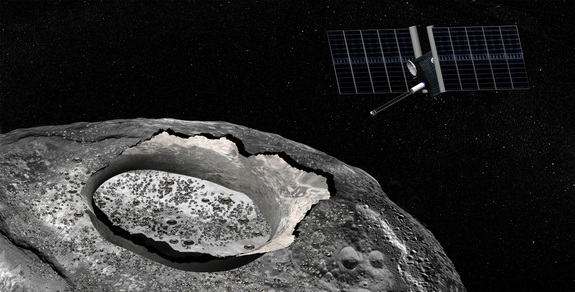 I read an article the other day about how scientists would like to send a probe to an asteroid called Psyche (16 Psyche). The article itself focused on the fact that the asteroid is thought to be made up almost entirely of iron-nickel. It is irregularly shaped at 240x185x140 kilometers.
I read an article the other day about how scientists would like to send a probe to an asteroid called Psyche (16 Psyche). The article itself focused on the fact that the asteroid is thought to be made up almost entirely of iron-nickel. It is irregularly shaped at 240x185x140 kilometers.
This was not a particularly “sexy” science article and didn’t attract the usual stream of trolls. A healthy number of the comments were from science geeks like myself. I’m not sure they would embrace the term geek, as do I.
Much of the talk centered around bringing Psyche into Earth orbit and mining the metal. One person mentioned the weight of Psyche 2.27x10E+19 (10 times 10 times 10, nineteen times) kilograms and how moving such a massive object would not be easy. Most people skipped right over this reality. I think because the number is really too large to fully comprehend.
I wanted to see if I could figure out the math and maybe get an idea in my mind how big is BIG. The NASA calculation is based on the influence that Psyche has on the orbit of objects around it but I hoped to figure out how much a roughly 200 kilometer sphere of iron would weigh. Math is not my strong suit so off to the Internet I went.
We need to be able to calculate the volume of a sphere and know the density of iron.
The volume of a sphere is calculated by this formula: 4/3*Pi*radius^3 (cubed).
Iron has a density of 7.87 grams per cubic centimeter.
So to get the volume comparable with the density we need to convert the roughly 200 kilometers into centimeters. Easily done. There are 100 centimeters in a meter and 1,000 meters in a kilometer so there are 100,000 centimeters in a kilometer. Multiply that by 200 and we get 20 million centimeters.
Our equation thus reads 4/3*Pi*20,000,000^3.
The next thing we need to know is that math isn’t always done left to right, it’s done by something called an Order of Operations. Some of you might remember Please Excuse My Dear Aunt Sally. The operator takes precedent over left to right.
- Parenthesis
- Exponential
- Multiply and Divide
- Add and Subtract
The upshot of that is we take 20 million cubed first. Then go back and take 4/3*Pi and multiply the cubed result by that. The volume is 3.35103E+22.
From here is relative simple to multiply that result by the 7.87 grams per cubic centimeter density of iron and then convert grams into pounds for many in my audience. I ended up with a result of 5.81E+20 lbs or 2.64E+20 kilograms.
My numbers don’t match the official mass of Psyche likely because I roughly guessed the spherical size and based the entire weight on the density of iron. Both of these were estimates but the result I got is fairly close to the official mass and I think I’ve done my math right.
What’s the point of all this?
When it is noted that Psyche has a mass of about 2.27x10E+19 kilograms what we are really saying is that it weighs this much:
- 22,700,000,000,000,000,000 kilograms
- 50,044,933,515,967,200,000 pounds.
No wonder most people just skipped over it. That number is so big it’s almost as if it doesn’t exist at all. We cannot imagine such a thing and yet Psyche is just a fairly large object in the asteroid belt. The biggest object in the asteroid belt is called Ceres and contains more fresh water than is found on earth.
What’s the point of all of this?
I suppose I’m suggesting that we stop and smell the density. Having a great idea, mining iron from Psyche, is a good thing; but don’t ignore obstacles because they are difficult to grasp. They are the most important thing to consider in any plan.
Think about how Big is Big and what difficulties it presents. Not just in mining an asteroid but in everything you do.
Tom Liberman
Sword and Sorcery fantasy with a Libertarian Ideology
Current Release: The Spear of the Hunt
Next Release: The Broken Throne
This reminded me of this BBC video; https://www.youtube.com/watch?v=NtMwAUaftSU
Yeah, my little equation is kiddy-work in the numbers game. Still, it’s big enough to make me go wow!
Thanks for the comment!
Tom